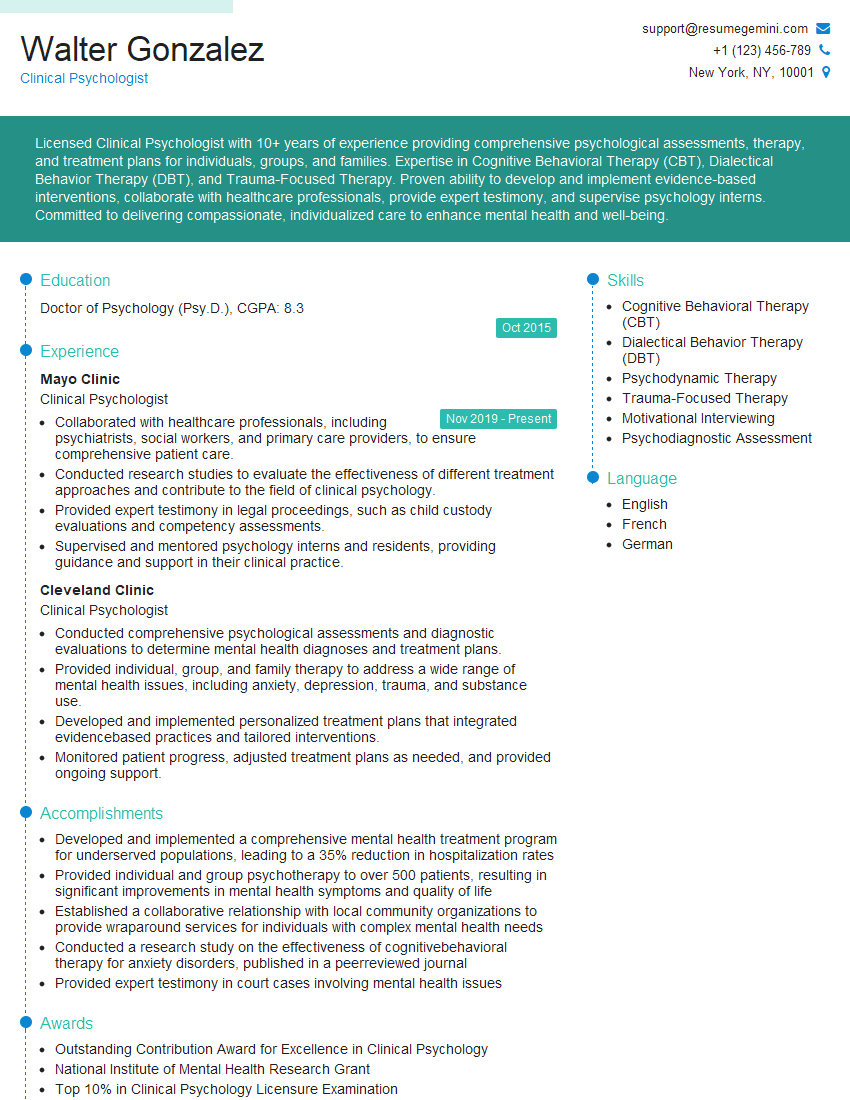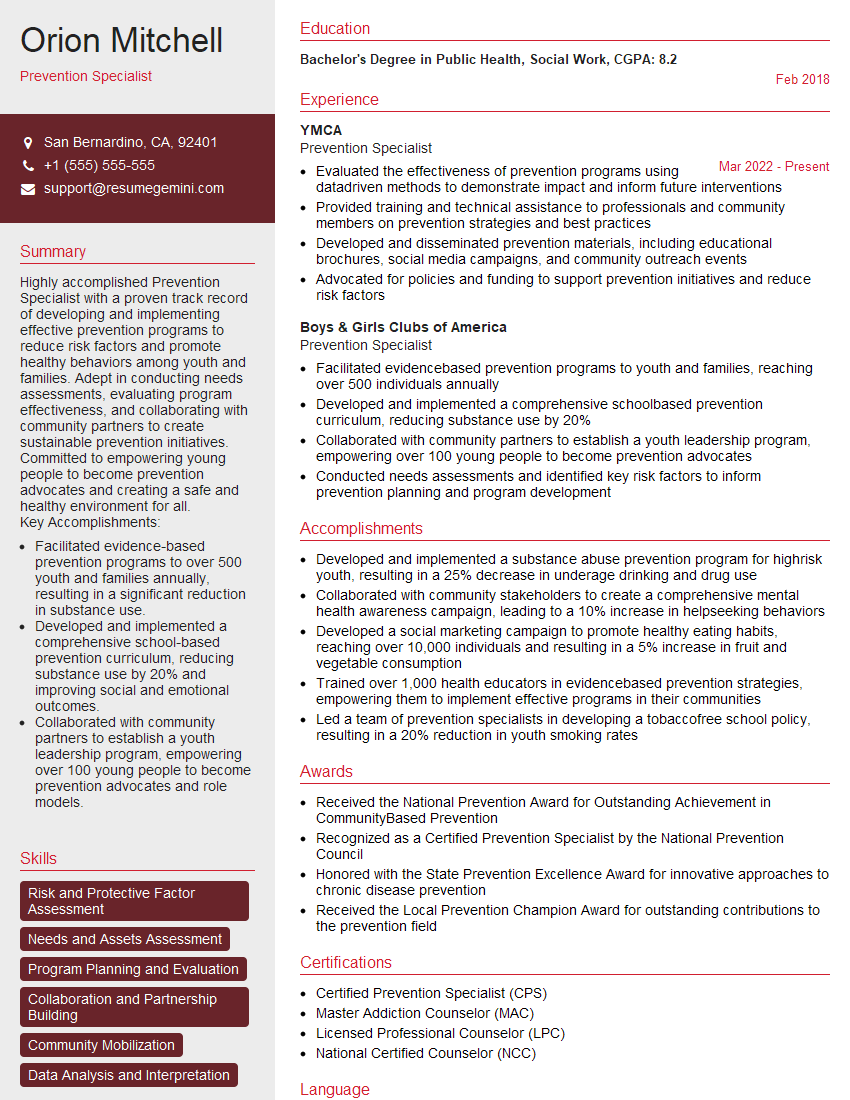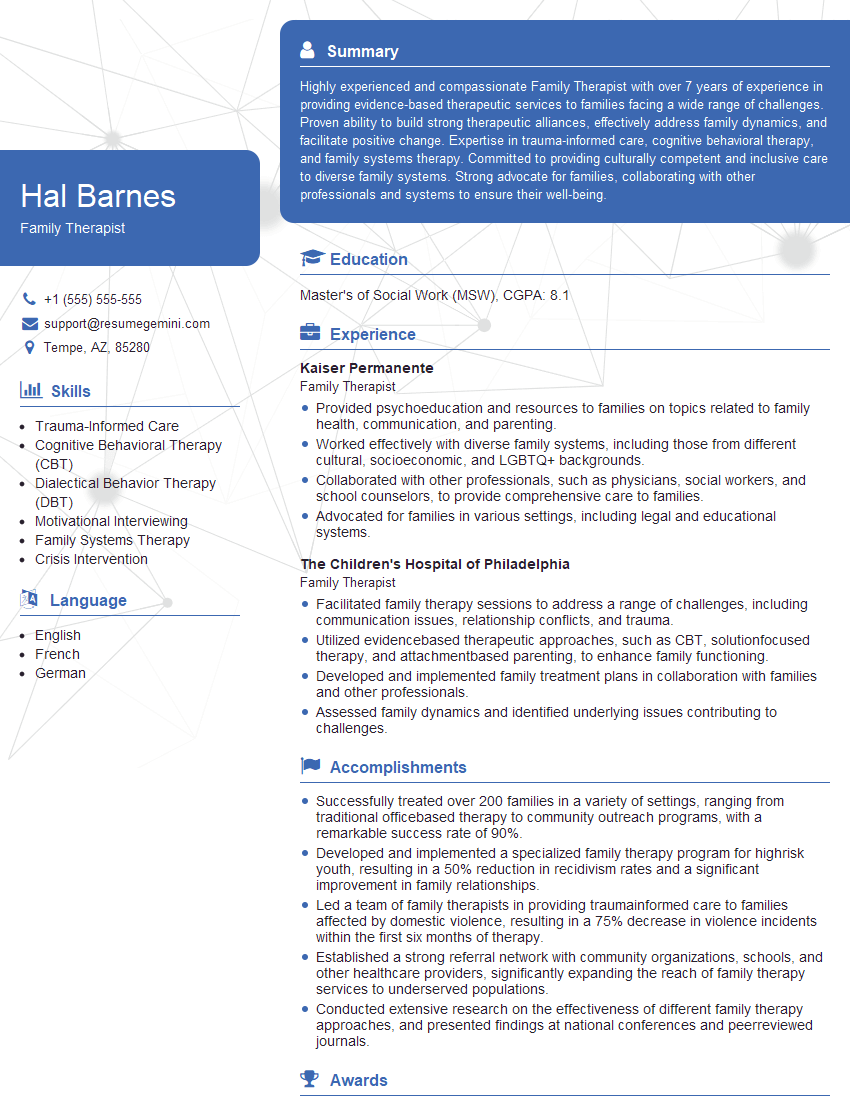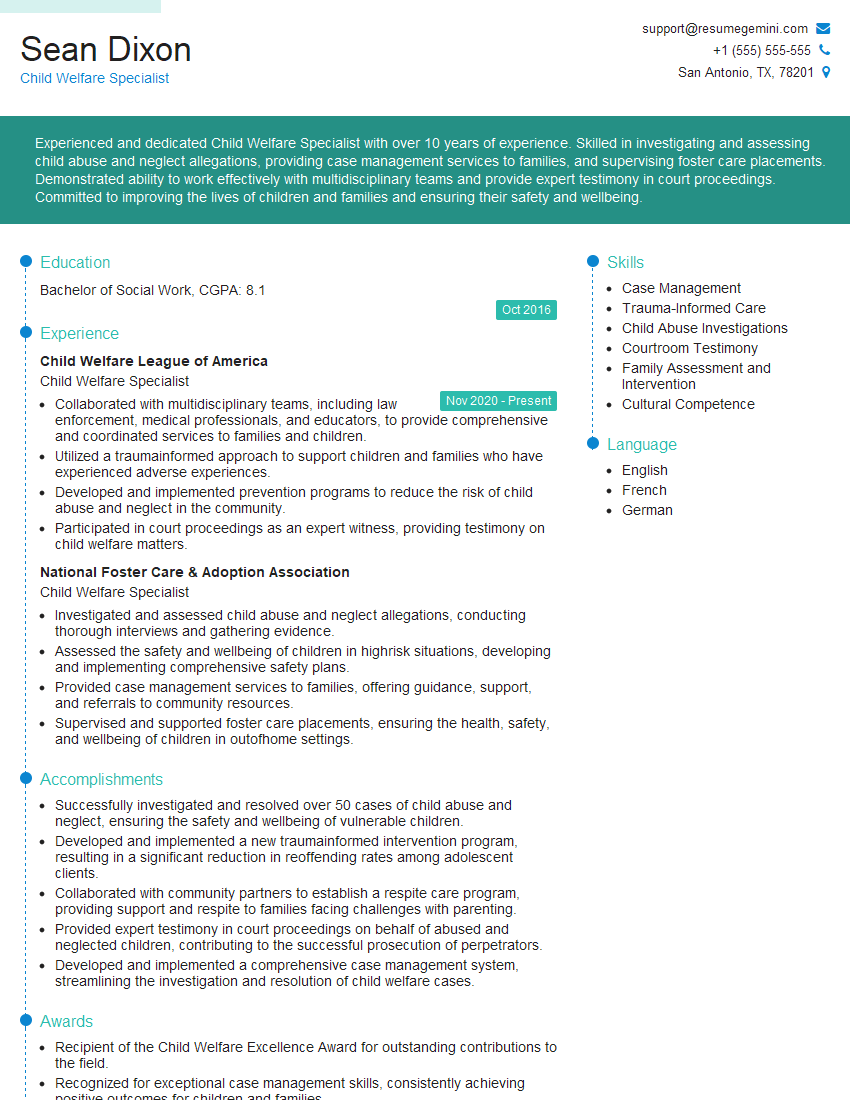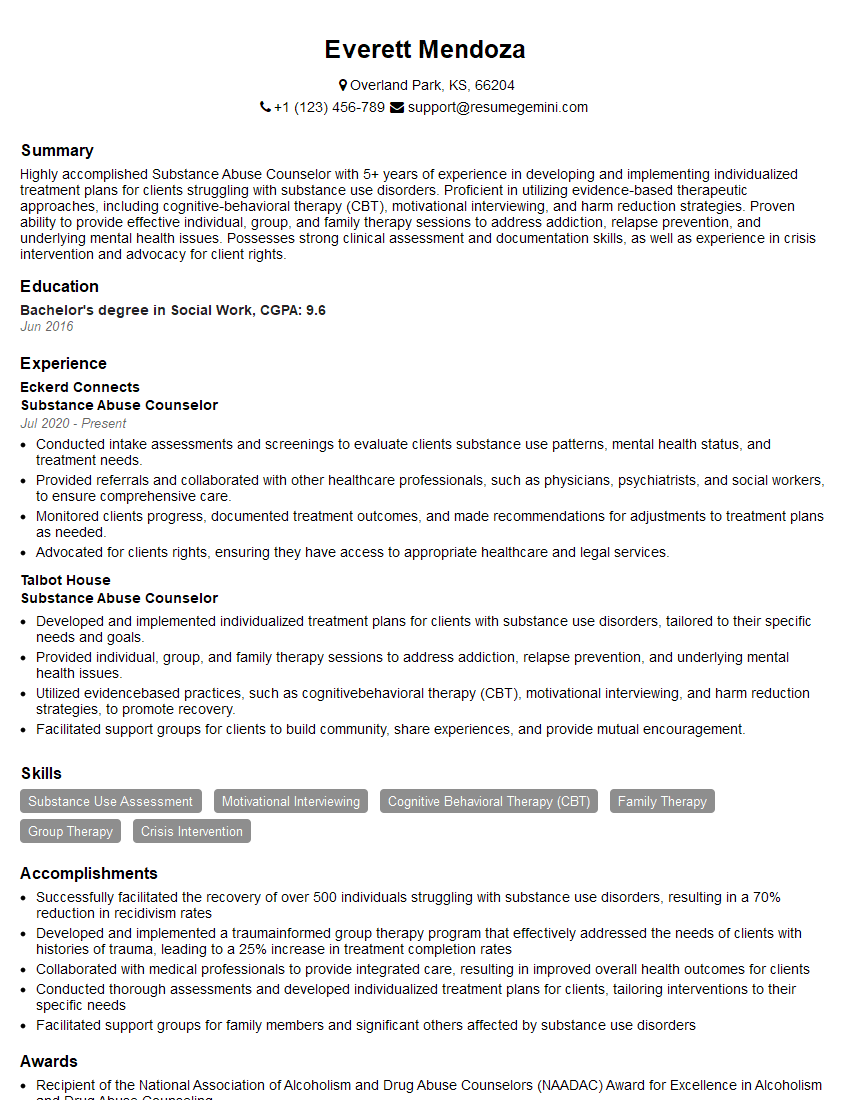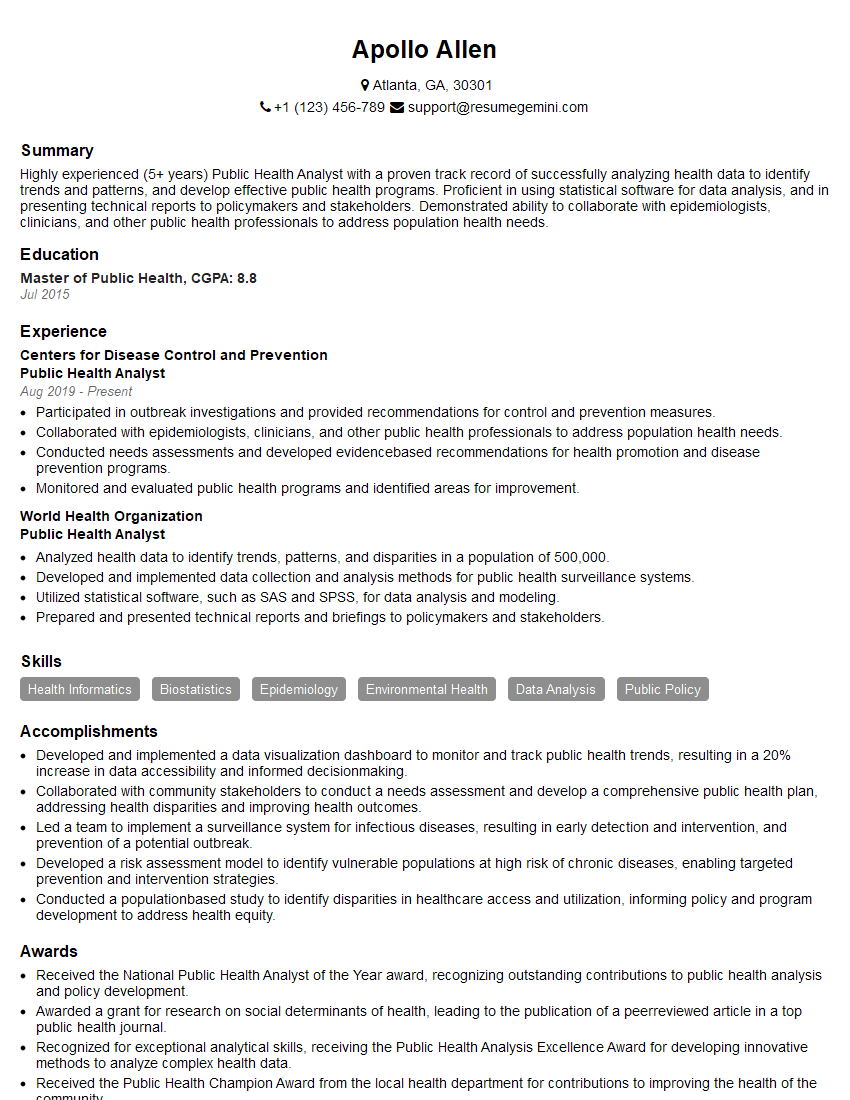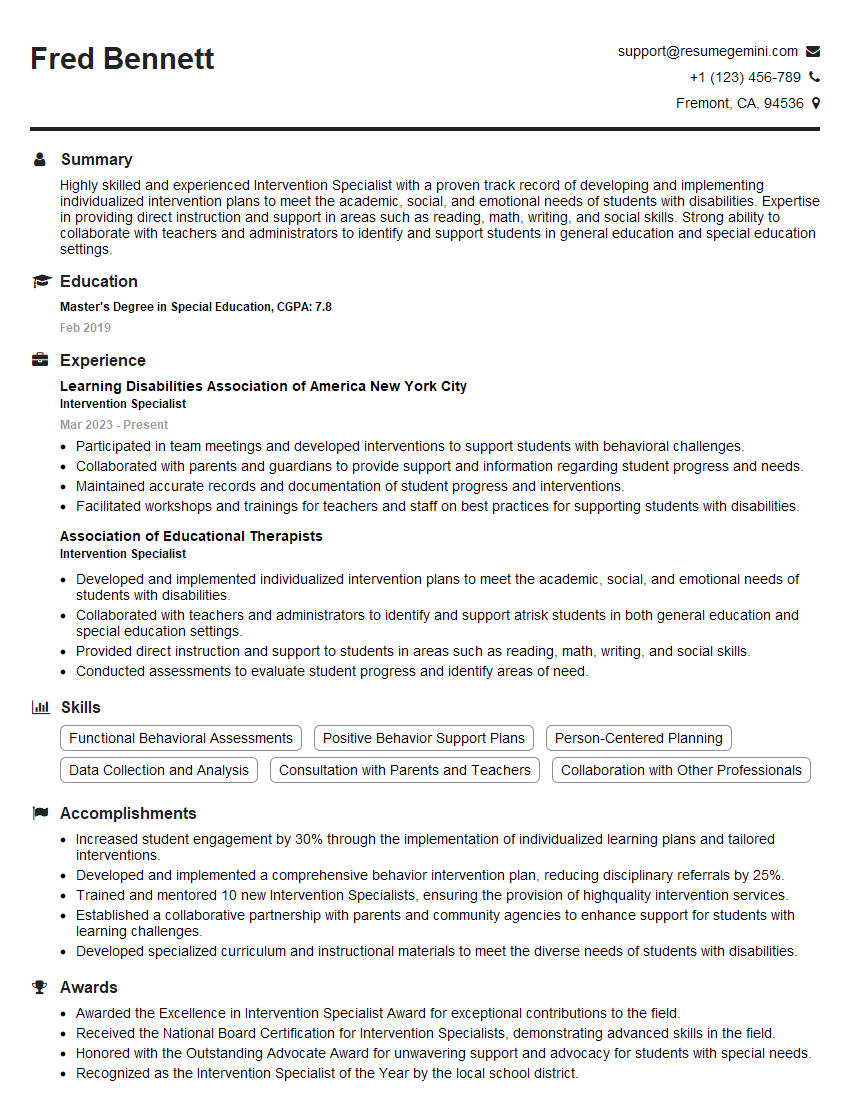The right preparation can turn an interview into an opportunity to showcase your expertise. This guide to Risk and Protective Factors interview questions is your ultimate resource, providing key insights and tips to help you ace your responses and stand out as a top candidate.
Questions Asked in Risk and Protective Factors Interview
Q 1. Define risk and protective factors in the context of child development.
Risk and protective factors are elements in a child’s environment and life that either increase or decrease the likelihood of negative outcomes. Risk factors are circumstances, experiences, or characteristics that make it more likely that a child will experience difficulties, such as academic problems, behavioral issues, or mental health challenges. Protective factors, on the other hand, are those that buffer against the negative effects of risk, increasing the likelihood of positive development and resilience.
Think of it like a seesaw: Risk factors push the seesaw down toward negative outcomes, while protective factors push it up toward positive outcomes. A balance of these factors determines the child’s developmental trajectory.
Q 2. Explain the difference between distal and proximal risk factors.
Distal and proximal risk factors differ in their proximity to the outcome. Distal risk factors are those that are more remote or indirect influences. They often represent broader societal, community, or familial conditions that set the stage for later problems. Examples include poverty, parental substance abuse (long before a child’s immediate experiences), or exposure to community violence.
Proximal risk factors, conversely, are immediate and direct influences that more closely precede the negative outcome. These are more immediate stressors affecting the child directly. Examples include child abuse, neglect, inconsistent parenting styles, or exposure to traumatic events.
For instance, parental unemployment (distal) might lead to increased family stress and harsh parenting (proximal), increasing the risk of a child developing behavioral problems. Understanding both levels is crucial for effective intervention.
Q 3. Describe three common risk factors for adolescent substance abuse.
Three common risk factors for adolescent substance abuse include:
- Peer influence: Adolescents are highly susceptible to peer pressure, and if their friends engage in substance use, they are much more likely to try it themselves.
- Family history of substance abuse: Genetics and family dynamics play a significant role. Children from families with a history of substance abuse are at a higher risk, partly due to genetic predisposition and learned behaviors.
- Easy access to substances: The availability of drugs and alcohol in the environment significantly impacts adolescent substance use. This could stem from lax parental supervision, community issues, or easy online access.
It’s crucial to understand that these factors often interact, meaning the presence of multiple risks increases the likelihood of substance abuse significantly more than the individual risks in isolation.
Q 4. Identify three protective factors that promote resilience in children facing adversity.
Three protective factors that promote resilience in children facing adversity are:
- Positive parent-child relationship: A strong, loving, and supportive relationship with at least one parent or caregiver provides a secure base from which to navigate challenges. This includes consistent affection, clear expectations, and effective communication.
- Strong community connections: Belonging to a supportive community, including positive peer groups, mentors, and community organizations, can provide additional emotional and practical support during difficult times. A sense of belonging is hugely protective.
- Child’s self-esteem and coping skills: Children who have a positive self-image, are confident in their abilities, and have developed effective coping mechanisms (like problem-solving skills) are more likely to overcome adversity. This is developed through positive experiences and encouragement.
Q 5. How do you assess risk and protective factors in a family setting?
Assessing risk and protective factors in a family setting involves a multifaceted approach that combines various methods. It’s rarely a single interview or questionnaire, but rather a comprehensive process.
- Structured interviews: Standardized interviews with parents and children are conducted to assess family dynamics, parenting practices, child behavior, and exposure to stressful life events. These interviews use standardized questionnaires to ensure consistency.
- Observations: Direct observation of family interactions during sessions can provide valuable insights into communication patterns, conflict resolution styles, and emotional expression.
- Collateral information: Information from other sources, such as teachers, medical professionals, or extended family members, adds additional perspectives and can help triangulate information.
- Review of records: Relevant records, such as school records, child welfare reports, or medical records, provide valuable contextual data.
The process aims to identify both strengths and vulnerabilities within the family system to inform interventions that target specific risks and enhance protective factors.
Q 6. What are some common data sources used to identify risk and protective factors?
Several data sources are valuable for identifying risk and protective factors:
- Administrative data: This encompasses data from schools (attendance, grades, disciplinary actions), healthcare systems (medical records), and child welfare agencies (reports of abuse or neglect). It provides a quantitative perspective.
- Surveys and questionnaires: These can assess parental attitudes, child behaviors, and family characteristics. They allow for more detailed information and can target specific populations.
- Clinical assessments: Psychological evaluations and diagnostic assessments provide in-depth insights into individual functioning and mental health. These are particularly valuable when mental health issues are involved.
- Qualitative data: Data gathered through interviews, focus groups, and observations provides richer qualitative insights into the lived experiences of families and communities. This can uncover nuances often missed in quantitative data.
Combining different data sources creates a more comprehensive understanding of the factors affecting a child’s well-being.
Q 7. Explain the ecological model of risk and protective factors.
The ecological model views child development within a nested system of interconnected influences. It recognizes that a child’s well-being is shaped by multiple levels of context, rather than solely by individual characteristics. These levels include:
- Microsystem: The immediate environment, such as family, school, and peer groups.
- Mesosystem: The interactions between microsystems, for example, the relationship between a child’s parents and their teachers.
- Exosystem: External settings that indirectly influence the child, such as parents’ workplaces or community resources.
- Macrosystem: The broader cultural context, including societal values, beliefs, and policies.
- Chronosystem: The influence of time and historical events on the other systems.
Understanding risk and protective factors within this framework highlights the interconnectedness of influences. For example, poverty (macrosystem) might affect parental stress (microsystem), leading to inconsistent parenting (microsystem) and increased risk of child behavioral problems. Interventions should consider all relevant levels of the ecological system to be effective.
Q 8. How do you prioritize risk factors when multiple factors are present?
Prioritizing risk factors when multiple are present requires a systematic approach. It’s not simply about which factor is the ‘biggest,’ but rather which poses the most immediate and significant threat to the individual or system being assessed. We use a multi-faceted strategy combining severity, probability, and potential impact.
- Severity: How serious is the potential consequence of the risk? A risk of serious injury is obviously more severe than a minor inconvenience.
- Probability: How likely is the risk to occur? A highly probable risk, even if the consequence is relatively minor, might still take precedence.
- Potential Impact: How widespread or long-lasting will the consequences be? A risk with a smaller probability but potentially devastating impact needs to be prioritized.
For example, imagine assessing risks for a child: While bullying (high probability, moderate severity) and parental substance abuse (moderate probability, high severity) both present substantial risks, parental substance abuse might be prioritized due to its potential for broader and more lasting negative impacts on the child’s development and well-being. A structured risk matrix, often with a numerical scoring system, can facilitate this prioritization.
Q 9. Discuss the role of cultural factors in assessing risk and protective factors.
Culture profoundly influences both the identification and interpretation of risk and protective factors. What might be considered a risk in one culture could be a neutral or even protective factor in another. For example, strong family ties, a significant protective factor in many cultures, might be less influential in a highly individualistic society. Cultural norms surrounding communication, discipline, and problem-solving also shape the expression and impact of risk factors.
Assessing risk and protective factors requires culturally sensitive approaches. This involves understanding the cultural context of the individual or community, utilizing culturally appropriate assessment tools and methods, and engaging interpreters or culturally competent professionals when needed. Ignoring cultural factors can lead to inaccurate assessments and ineffective interventions.
For instance, a community’s view on mental health can significantly impact the identification and reporting of mental health challenges. In some cultures, open discussion of mental health is stigmatized, leading to underreporting and delayed intervention.
Q 10. How do you incorporate a strengths-based approach in assessing risk and protective factors?
A strengths-based approach focuses on identifying and utilizing an individual’s or community’s existing resources, resilience, and capabilities to mitigate risks and promote well-being. It moves beyond simply identifying deficits and focuses on building upon existing strengths.
In assessing risk and protective factors, this means actively seeking out positive attributes, skills, and supports. Questions might shift from ‘What are the problems?’ to ‘What are the individual’s coping mechanisms?’, ‘What are their social supports?’, and ‘What are their personal talents?’ This information is then integrated into the overall risk assessment to develop interventions that build upon these strengths rather than just addressing weaknesses.
For instance, a child exhibiting behavioral challenges might also demonstrate strong artistic talent. A strengths-based approach would leverage this artistic talent as a therapeutic outlet, potentially reducing the behavioral challenges while fostering self-esteem. This collaborative approach fosters empowerment and self-efficacy.
Q 11. Describe a specific intervention strategy you’ve used to mitigate a risk factor.
In working with adolescents at risk for substance abuse, I implemented a peer-led mentorship program. This intervention directly targeted the risk factor of peer influence – a common factor contributing to substance initiation. The program trained high-achieving, positive-role-model students to mentor at-risk peers.
The mentorship focused on developing positive social skills, building self-esteem, and providing support and guidance in navigating social pressures. The program included regular check-ins, group activities, and community service projects. Evaluation showed a significant reduction in substance experimentation among the mentored adolescents compared to a control group.
This intervention’s success stemmed from directly addressing a key risk factor through a culturally relevant and engaging approach, leveraging the power of positive peer influence to create a protective factor.
Q 12. Explain how you would develop a risk management plan.
Developing a comprehensive risk management plan involves a structured process:
- Risk Identification: Systematically identify potential hazards or risks. This involves brainstorming, reviewing incident reports, and utilizing checklists.
- Risk Analysis: Analyze each identified risk, assessing its likelihood and potential impact. This might involve using a risk matrix to prioritize risks.
- Risk Evaluation: Determine the level of risk acceptability. This involves weighing the potential impact against the resources available for mitigation.
- Risk Treatment: Develop and implement strategies to address the identified risks. This might include avoidance, mitigation (reducing likelihood or impact), transfer (insurance), or acceptance (acknowledging the risk and planning for potential consequences).
- Risk Monitoring and Review: Regularly monitor the effectiveness of the implemented strategies and review the risk management plan periodically to make necessary updates based on changing circumstances or new information.
The plan should be documented, communicated to relevant stakeholders, and regularly updated to reflect changes in the environment or new insights.
Q 13. What are some limitations of risk assessment tools?
Risk assessment tools, while valuable, have limitations:
- Bias: Tools can reflect biases of their creators, potentially leading to inaccurate or unfair assessments. Cultural biases are a significant concern.
- Oversimplification: Complex human behavior and social contexts are often simplified in assessment tools, potentially missing crucial nuances.
- Limited Predictive Validity: While tools can identify risk factors, they don’t always accurately predict future outcomes. Many factors influence outcomes, and tools often cannot capture this complexity.
- Lack of Context: Tools might not adequately account for the individual’s specific context, including their strengths, resources, and support systems.
- Reliability and Validity Concerns: The reliability and validity of the tools themselves must be established through rigorous research. Tools should be tested for accuracy and consistency.
It’s crucial to use multiple methods for assessment and to interpret results cautiously, taking into account individual context and limitations of the tool itself.
Q 14. How do you ensure confidentiality and ethical considerations when working with sensitive risk information?
Confidentiality and ethical considerations are paramount when working with sensitive risk information. This requires adherence to strict ethical guidelines and relevant legal regulations (e.g., HIPAA, FERPA). Key considerations include:
- Informed Consent: Obtaining informed consent from individuals before collecting or disclosing their information. This includes clearly explaining the purpose of the assessment, how the information will be used, and who will have access to it.
- Data Security: Implementing robust security measures to protect the confidentiality of sensitive data, including secure storage, access controls, and encryption.
- Data Minimization: Only collecting and retaining the minimum necessary information to fulfill the purpose of the assessment.
- Anonymization/De-identification: Anonymizing or de-identifying data whenever possible to protect individual privacy.
- Reporting and Disclosure: Following established protocols for reporting and disclosing information, ensuring compliance with legal and ethical obligations, and prioritizing the safety and well-being of the individual.
- Maintaining Professional Boundaries: Establishing and maintaining appropriate professional boundaries to avoid conflicts of interest or breaches of confidentiality.
Ethical practice also involves recognizing the limitations of one’s own expertise and seeking supervision or consultation when needed. It’s about acting responsibly and ethically with the sensitive information entrusted to you.
Q 15. Describe your experience working with families facing multiple risk factors.
Working with families facing multiple risk factors requires a holistic and individualized approach. My experience involves assessing the interplay of various risk factors – such as poverty, domestic violence, parental substance abuse, and lack of social support – to understand their cumulative impact on the family’s well-being. I employ a strengths-based perspective, focusing not only on the challenges but also on identifying and leveraging the family’s existing resources and resilience.
For example, I worked with a family where the parents were struggling with unemployment, substance abuse, and unstable housing. Instead of solely focusing on the negative aspects, I also highlighted the parents’ commitment to their children, their past successes in overcoming challenges, and their desire for a better life. This allowed us to collaboratively develop a plan focusing on securing employment, accessing addiction treatment, and obtaining stable housing, all while reinforcing their existing parental strengths.
This approach includes active listening, building rapport, and creating a collaborative environment where the family feels empowered to participate in their own recovery and growth. It’s about moving beyond simple problem-solving and fostering long-term resilience within the family unit.
Career Expert Tips:
- Ace those interviews! Prepare effectively by reviewing the Top 50 Most Common Interview Questions on ResumeGemini.
- Navigate your job search with confidence! Explore a wide range of Career Tips on ResumeGemini. Learn about common challenges and recommendations to overcome them.
- Craft the perfect resume! Master the Art of Resume Writing with ResumeGemini’s guide. Showcase your unique qualifications and achievements effectively.
- Don’t miss out on holiday savings! Build your dream resume with ResumeGemini’s ATS optimized templates.
Q 16. How do you collaborate with other professionals to address risk factors?
Collaboration is crucial in addressing risk factors effectively. I regularly work with a multidisciplinary team, including social workers, therapists, educators, medical professionals, and community support organizations. This collaborative approach ensures a comprehensive assessment of the family’s needs and allows us to leverage the expertise of each professional. We utilize case conferences, regular communication, and shared case management platforms to coordinate efforts and avoid duplication. The goal is to create a seamless and integrated support system for the family.
For instance, in a case involving a child with behavioral issues stemming from parental conflict and neglect, I collaborated closely with the child’s teacher to understand their classroom behavior and academic performance. This information, combined with my assessment of the home environment and parental capacity, helped us develop a comprehensive intervention plan that addressed both the child’s needs and the underlying family dynamics. Regular communication and joint planning sessions ensured a consistent and supportive approach across all settings.
Q 17. Describe a situation where you had to make a difficult decision based on a risk assessment.
One challenging decision involved a family with a history of domestic violence and child neglect. After a thorough risk assessment, which included interviews with the family, observations, and review of relevant documentation, I determined the children were at significant risk of further harm. The decision to recommend child protective services intervention was difficult, as it involved separating the children from their parents. However, prioritizing the children’s safety and well-being was paramount.
The decision-making process involved careful consideration of all available information, ethical guidelines, and legal requirements. I documented the reasoning behind the recommendation thoroughly and ensured the family was informed of the process and their rights throughout the procedure. Following the intervention, I continued to support the family by facilitating access to resources like parenting classes, anger management programs, and counseling services, aiming to achieve reunification while ensuring the children’s safety.
Q 18. How do you measure the effectiveness of your risk mitigation strategies?
Measuring the effectiveness of risk mitigation strategies involves both quantitative and qualitative methods. Quantitative measures might include tracking the frequency of negative incidents (e.g., domestic violence episodes, child absences from school), improvements in family functioning (e.g., increased parental engagement, improved child behavior), and changes in social support networks.
Qualitative measures involve ongoing assessments of family progress through interviews, observations, and feedback from the family and other involved professionals. We also utilize standardized assessments to track changes in specific areas, such as parental stress levels or child mental health. Regular reviews and adjustments to our strategies ensure we remain responsive to the evolving needs of the family.
For example, we might use pre and post-intervention surveys to measure changes in parental knowledge of child development or track the frequency of family conflicts. Combining quantitative and qualitative data provides a more complete understanding of the effectiveness of our intervention, allowing for adjustments to maximize positive outcomes.
Q 19. What are some common challenges in working with families dealing with risk factors?
Working with families dealing with risk factors presents several challenges. Resource limitations, both financial and in terms of available services, can significantly hinder our efforts. The families themselves often face multiple, interconnected problems, requiring a complex and coordinated response. Furthermore, maintaining trust and engagement with families who may be distrustful of authority figures or struggling with mental health issues can be particularly challenging. Finally, the emotional toll on professionals working in this field is substantial, emphasizing the need for self-care and supportive supervision.
Q 20. How do you adapt your approach when working with diverse populations?
Adapting my approach to diverse populations is crucial. This involves being culturally sensitive and aware of the unique challenges faced by different cultural groups. This includes understanding potential language barriers, cultural beliefs and practices relating to family dynamics and parenting, and potential biases within assessment tools. I actively seek to build relationships based on trust and mutual respect, employing culturally appropriate communication styles and adapting interventions to align with the family’s cultural context.
For instance, when working with immigrant families, I might collaborate with bilingual staff or interpreters, utilize culturally relevant resources, and take into account the family’s acculturation level and experiences with the healthcare and social services systems. Always ensuring that the chosen approach respects their cultural values and beliefs is critical for successful intervention.
Q 21. Explain the concept of cumulative risk.
Cumulative risk refers to the accumulation of multiple risk factors over time. It’s not simply the sum of individual risks, but rather the synergistic effect of these risks, where the impact of multiple risks is often greater than the sum of their individual effects. Imagine a child growing up in poverty, experiencing parental substance abuse, and attending a poorly performing school. Each factor individually poses a risk, but the combination significantly increases the likelihood of negative outcomes such as school failure, mental health problems, and involvement in the juvenile justice system.
Understanding cumulative risk is crucial for effective intervention. It emphasizes the need for a holistic approach that addresses multiple risk factors simultaneously, focusing not only on individual challenges but also on the interplay between them. By recognizing the synergistic nature of risk factors, we can develop more effective prevention and intervention strategies, aiming to reduce the overall burden of risk on individuals and families.
Q 22. Describe the importance of early identification of risk factors.
Early identification of risk factors is crucial because it allows for timely intervention, potentially preventing negative outcomes. Think of it like a wildfire – the earlier you spot the spark, the easier it is to extinguish it before it becomes a devastating blaze. Identifying risk factors early means we can implement preventative measures and build protective factors to safeguard children and families.
For example, if we identify a child experiencing significant parental conflict at home, we can intervene early with family therapy or parenting support programs. This prevents the conflict from escalating and negatively impacting the child’s development, such as emotional or behavioral problems. Early intervention is more effective and often less costly than dealing with the consequences of a problem that has progressed.
- Risk factors are variables that increase the likelihood of negative outcomes (e.g., poverty, parental substance abuse, domestic violence).
- Protective factors are variables that buffer the impact of risk factors or promote positive outcomes (e.g., strong family support, positive school environment, access to quality healthcare).
Q 23. How do you handle situations where a child is at immediate risk of harm?
When a child is at immediate risk of harm, my priority is ensuring their safety. This involves a rapid assessment of the situation and immediate action. I would first contact the appropriate authorities, such as child protective services (CPS) or the police, depending on the nature of the threat. Simultaneously, I would provide support and care to the child, ensuring their immediate needs are met, including providing a safe space and comfort.
For instance, if I suspect a child is being physically abused, I will immediately report my concerns to CPS. While waiting for their arrival, I’ll ensure the child feels safe and secure, possibly by offering a quiet space and engaging in calming activities. Documentation is vital, recording all observations and actions taken. My role in these situations is to act as a mandated reporter, prioritizing the child’s well-being above all else. Collaboration with other professionals is key to ensure a coordinated response.
Q 24. What is your understanding of trauma-informed care?
Trauma-informed care is a framework that recognizes the widespread impact of trauma and emphasizes physical, psychological, and emotional safety for individuals. It shifts from a ‘what’s wrong with you?’ approach to a ‘what happened to you?’ understanding. This means understanding that past trauma can significantly shape an individual’s behavior and responses. We need to approach individuals with empathy, recognizing that past experiences may affect their ability to cope with present situations.
In practice, trauma-informed care prioritizes creating a safe and supportive environment. This includes establishing clear boundaries, promoting choice and autonomy, and empowering individuals to take control of their lives. It’s about building trust and collaboration, rather than imposing interventions. For example, instead of immediately pushing a traumatized child into group therapy, we might start with individual sessions focused on building trust and rapport.
Q 25. How do you incorporate evidence-based practices into your work with risk and protective factors?
Evidence-based practices are the cornerstone of my work. This means utilizing interventions and strategies that have been shown through research to be effective in addressing risk and protective factors. I regularly review the latest research from reputable sources, such as the Centers for Disease Control and Prevention (CDC) and the National Institutes of Health (NIH). I use this information to guide my assessments, interventions, and program development.
For example, I might incorporate evidence-based parenting programs to address parental stress and improve parenting skills, knowing that these programs have been proven to reduce child maltreatment. Or, I may use a specific therapeutic approach with a child that research indicates is particularly effective for children experiencing trauma. I’m constantly evaluating the effectiveness of my interventions and adapting my approach based on the latest research findings.
Q 26. Describe your experience with data analysis related to risk and protective factors.
Data analysis plays a crucial role in understanding the complex interplay of risk and protective factors. I have extensive experience using statistical software packages such as SPSS and R to analyze data from various sources, including surveys, administrative datasets, and clinical records. This allows me to identify trends, patterns, and relationships between different variables, which informs my understanding of the risk profile of individuals and populations.
For instance, I might analyze data to determine which risk factors are most strongly associated with child neglect in a specific community. This analysis would inform the development of targeted interventions focusing on those key risk factors. I also use data to track the effectiveness of different interventions over time and to make data-driven decisions about resource allocation.
Q 27. How do you stay updated on the latest research and best practices in risk and protective factors?
Staying current in this field is essential. I actively engage in continuous professional development through various avenues. This includes attending conferences and workshops, reading peer-reviewed journals (such as Child Development and Journal of Family Psychology), and participating in professional networks and online communities. I also regularly consult with colleagues and experts to stay abreast of new developments and best practices. This commitment to ongoing learning ensures I am equipped to provide the most effective and up-to-date services.
Key Topics to Learn for Risk and Protective Factors Interview
- Identifying and Assessing Risk Factors: Understanding the various types of risk factors (individual, family, community) and methods for their assessment (e.g., questionnaires, interviews, observations).
- Analyzing Protective Factors: Exploring the role of protective factors in mitigating risk and promoting resilience. Learn to identify and analyze individual, family, and community-level protective factors.
- Ecological Systems Theory Application: Understanding how risk and protective factors interact within various ecological systems (microsystem, mesosystem, exosystem, macrosystem) and the implications for intervention strategies.
- Developing Prevention and Intervention Strategies: Explore evidence-based approaches to addressing risk factors and strengthening protective factors across different populations and settings. This includes understanding program evaluation methods.
- Data Analysis and Interpretation: Gain proficiency in interpreting data related to risk and protective factors, including statistical significance and effect sizes. Practice applying this knowledge to real-world scenarios.
- Ethical Considerations: Discuss the ethical implications of working with vulnerable populations and the importance of confidentiality, informed consent, and cultural sensitivity.
- Risk and Protective Factors Across the Lifespan: Understand how risk and protective factors change and interact across different developmental stages.
- Specific Risk and Protective Factors in [Relevant Field, e.g., Child Welfare, Mental Health]: Deepen your knowledge of the specific risk and protective factors relevant to your target field.
Next Steps
Mastering Risk and Protective Factors is crucial for career advancement in fields demanding a deep understanding of human behavior and well-being. A strong grasp of these concepts demonstrates your ability to analyze complex situations, develop effective interventions, and contribute meaningfully to positive change. To significantly boost your job prospects, invest time in creating an ATS-friendly resume that showcases your skills and experience effectively. ResumeGemini is a trusted resource to help you build a professional and impactful resume. Examples of resumes tailored to Risk and Protective Factors are available to guide you. Use this opportunity to highlight your expertise and secure your dream role.
Explore more articles
Users Rating of Our Blogs
Share Your Experience
We value your feedback! Please rate our content and share your thoughts (optional).
What Readers Say About Our Blog
This was kind of a unique content I found around the specialized skills. Very helpful questions and good detailed answers.
Very Helpful blog, thank you Interviewgemini team.



